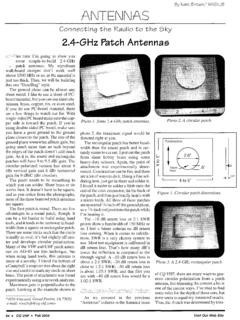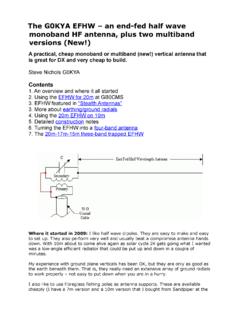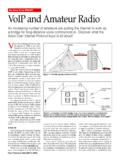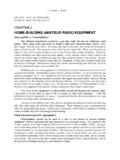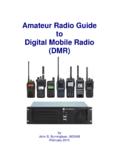Transcription of A Horizontal Loop Antenna for Shortwave Listening and ...
1 A Horizontal Loop Antenna for Shortwave Listening and amateur radio Use Overview: There is need for an Antenna design which meets the following criteria- easily constructed with home tools; made from locally-available, non-specialty materials (as much as practical); reasonable for single-person deployment; unobtrusive/low-observable;. omnidirectional; effective for a wide range of frequencies; durable under different weather conditions; and most importantly good performance. The Horizontal loop Antenna meets these criteria and performs very well.
2 I will show you how to construct and use one from materials you have available locally, with tools you should already have. Basic Specifications: Size: Varies with frequency range, the model I will show is approximately 287 feet of wire, arranged in a square shape, so about 72 feet per side, plus room to hang the Antenna . I will also discuss smaller models for space-limited applications. Cost: $0-$100- If you have some or all of the materials already on hand, or adapt what you have, the cost will be minimal.
3 If you need or want to buy everything, the price varies considerably, most of the cost will be the wire itself. Performance: This Antenna will be suitable for transmitting (with an appropriate tuner) from MHz to 54 MHz; and for receiving over a much greater range for Shortwave broadcasts. The design of this Antenna tends to pick up less atmospheric/electrical noise, so you reception will be quieter and more readable. It is also omnidirectional, which will allow you to receive broadcasts from any direction without moving or altering the Antenna .
4 NOTE: I will not delve into very technical aspects of Antenna design, as there are many texts out there available which will do a better job of it. Much of the information on antennas that is available on the internet is clouded with rumors, ignorance, and bias. Antennas work on the principles of physics, there is no secret way to improve performance short of working within these principles. All antennas are a compromise of some sort, I personally feel that for the application we're discussing, the Horizontal loop best fits the need.
5 Now, let's get started with an overview and the materials and tools needed. FIRST, though, we will talk about safety- you will be hanging wire in the air, which involves several safety concerns. ALWAYS ALWAYS ALWAYS be aware of your surroundings when working with antennas- electrical wires, falling tree limbs, and falls can kill you or your loved ones. NEVER. try to erect any Antenna remotely close to any utility lines, poles, lights, or commercial installations. Ensure that your Antenna is PROPERLY protected against lightning strikes and that you provide a proper ground for your station and antennas.
6 If you are uncomfortable or have questions, please contact me and we will help you or try to find someone local to you who can help. I assume no responsibility for the use or misuse of this document, you are responsible for your own safety. Now that the lawyer talk is out of the way, let's make some antennas! The Big Picture Overview of Loop The Horizontal Loop Antenna is one full wavelength at the lowest frequency used. The formula for calculating length is: 1,005/f=L. In other words, take 1,005; divide it by the lowest frequency in megahertz (MHz)- this result is the length in feet.
7 The Antenna I'm making here is for MHz (80 meter band), so 1,005 divided by equals or so. The length of the wire is not absolutely critical, a few inches either way will have little effect on performance. Another popular size is for the 40-meter band (7 MHz). The best part of this Antenna is that when transmitting, the Antenna loads well at EVERY. harmonic- the MHz Antenna will also perform well at 7, , 14, , etc. up to a certain point where performance starts to degrade. Luckily for us, most of those harmonics fall within other amateur bands.
8 For receiving, it should perform very well at all broadcast frequencies. There are tales on the internet and amongst Hams that this Antenna is a cloudwarmer , in other words, the radio energy goes straight up and warms the clouds . For long-range HF. communication, a low angle of radiation is desirable. However, this is true to some extent at the primary frequency, but at each harmonic, the angle of radiation gets lower, and there is actually some gain to be had at the higher harmonics. Height above ground and the type of ground will also affect this.
9 Again, for reception only, this will not matter nearly as much as for transmitting. A dipole Antenna is a bit simpler, but for 2 more supports, and a bit more wire, this design is no more complex to build, and performs much better overall. I will not discuss directional antennas here (Yagi, Log Periodic, etc) as they are far too complex to design and build for most people. They also require a support structure of some type and a means to aim the array, such as a rotor. They are also much more visible, and prone to damage from ice or tree limbs.
10 This Antenna is fed with coaxial cable (coax) of 50-ohm impedance. This cable is available either through radio equipment dealers or online. It is also available in many sizes and grades, which can be confusing. For the Shortwave listener or amateur HF operator, a good cable to use is called RG-8x . Unless you are transmitting using an amplifier, or working at VHF frequencies, this cable is more than sufficient for runs up to 150'. The cable will need to have PL-259 (aka UHF). connectors installed, if you don't have experience with this, either buy the cable with connectors pre-installed or find an experienced ham to help you.



